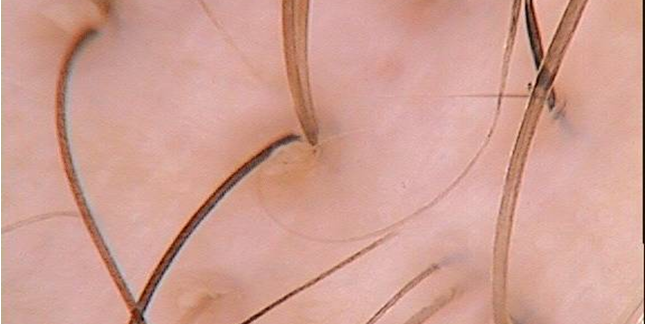Because they are not usually associated with an increased loss rate, male-pattern and female-pattern hair loss do not generally require testing. If hair loss occurs in a young man with no family history, drug use could be the cause.
- The pull test helps to evaluate diffuse scalp hair loss. Gentle traction is exerted on a group of hairs (about 40–60) on three different areas of the scalp. The number of extracted hairs is counted and examined under a microscope. Normally, fewer than three hairs per area should come out with each pull. If more than ten hairs are obtained, the pull test is considered positive.
- The pluck test is conducted by pulling hair out “by the roots”. The root of the plucked hair is examined under a microscope to determine the phase of growth, and is used to diagnose a defect of telogen, anagen, or systemic disease. Telogen hairs have tiny bulbs without sheaths at their roots. Telogen effluvium shows an increased percentage of hairs upon examination. Anagen hairs have sheaths attached to their roots. Anagen effluvium shows a decrease in telogen-phase hairs and an increased number of broken hairs.
- Scalp biopsy is used when the diagnosis is unsure; a biopsy allows for differing between scarring and nonscarring forms. Hair samples are taken from areas of inflammation, usually around the border of the bald patch.
- Daily hair counts are normally done when the pull test is negative. It is done by counting the number of hairs lost. The hair from the first morning combing or during washing should be counted. The hair is collected in a clear plastic bag for 14 days. The strands are recorded. If the hair count is >100/day, it is considered abnormal except after shampooing, where hair counts will be up to 250 and be normal.
- Trichoscopy is a noninvasive method of examining hair and scalp. The test may be performed with the use of a handheld dermoscope or a video dermoscope. It allows differential diagnosis of hair loss in most cases.
There are two types of identification tests for female pattern baldness: the Ludwig Scale and the Savin Scale. Both track the progress of diffused thinning, which typically begins on the crown of the head behind the hairline, and becomes gradually more pronounced. For male pattern baldness, the Hamilton–Norwood scale tracks the progress of a receding hairline and/or a thinning crown, through to a horseshoe-shaped ring of hair around the head and on to total baldness.
In almost all cases of thinning, and especially in cases of severe hair loss, it is recommended to seek advice from a doctor or dermatologist. Many types of thinning have an underlying genetic or health-related cause, which a qualified professional will be able to diagnose.
